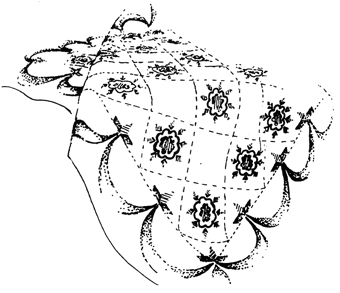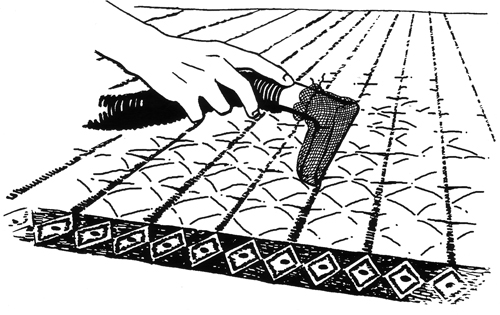G1821
Care of Quilts: Cleaning
This publication addresses the cleaning of fragile quilts.
Shirley M. Niemeyer, Professor, Extension Specialist, Environment/Housing/Textiles
Patricia C. Crews, Willa Cather Professor of Textiles, Clothing and Design and Director,
International Quilt Study Center & Museum
- To Clean or Not to Clean?
- Airing
- Vacuuming
- To Wet Clean or Not?
- Summary
- For More Information
- Resources
- Acknowledgments
 |
To Clean or Not to Clean?
Quilts need special care in cleaning, but even professionals do not always agree on the best methods or even whether it should be done. No two quilts are alike. Methods suited for cleaning one quilt may not be best for another. The fiber content, dyes and construction make each one unique. Sometimes it may be advisable to clean a quilt. Usually it is best to leave it as is.
Deciding whether to clean a quilt involves careful thought. How valuable is it to you? How will you feel if it is damaged by your choice of cleaning method? Do you have the equipment and space to clean the quilt? What is the fiber content? Can it withstand movement or agitation? Will the colors bleed or fade? Improper cleaning can permanently damage your quilt.
Make your decision carefully. Very old, fragile or valuable quilts should be cleaned by a professional textile conservator — not at home. Contact a local or area museum, university or the American Institute for Conservation, 1717 K St., NW, Suite 200, Washington, D.C. 20006, (202) 452-9545, for names of professional conservators in your area. If you decide to attempt cleaning a sturdy quilt yourself, the following recommendations will serve as a useful guide.
Airing
A musty smell often can be diminished by airing quilts in a shaded area outdoors or in a well-ventilated area indoors. Place a large plastic sheet on the ground or floor, cover it with a clean white sheet, and then lay the quilt on top of the sheet for airing. Air quilts away from direct sunlight as direct sunlight or bright indoor light fades colors and weakens fibers. Do not drape quilts over clotheslines. The yarns and fibers are strained, and the weight can break stitches or tear fabrics. Never beat or shake a quilt to remove dust.
Vacuuming
Small particles of airborne dust and dirt can abrade fibers and damage the quilt. They may be removed by vacuuming. Use a vacuum cleaner set on low suction so that the quilt is not pulled into the nozzle. Vacuuming may be the only safe method of removing soil — especially when dyes and inked signatures are not colorfast — when there are glazed finishes or when fabrics are fragile. Even vacuuming may be too harsh for extremely fragile fabrics.
Lay the quilt on a smooth, flat surface. If the quilt is strong with no tears or holes, you can place a piece of nylon hose, or sheer polyester fabric or cheesecloth over the nozzle of your vacuum hose, securing it tightly with rubber bands. If your quilt has weak or ragged areas, find a piece of fiberglass or nylon window screening roughly 2 feet by 3 feet. Wash it twice — once with detergent and once without — to remove any finishes or soil. Place the screening over the quilt so that it is between the quilt and the vacuum nozzle. Wash your hands well. Choose a low suction setting and hold the vacuum nozzle 1/2 inch to 1 inch above the surface of the quilt (about the width of your finger) and move it slowly across the entire surface. It is easiest to guide the hose with one hand and use your other hand to support the tip of the nozzle. The nozzle covering or screening is added protection against damaged areas being disturbed by the vacuum suction. Continue cleaning sections until the entire quilt is vacuumed. Repeat the procedure for the other side.
 |
| Figure 1. Small particles of dust and dirt abrade fibers and damage the quilt. One cleaning method is to lay out the quilt and carefully vacuum it. Place a section of sheer polyester or cotton cheesecloth over the vacuum nozzle to prevent the quilt from being pulled into the nozzle. |
To Wet Clean or Not?
Cleaning quilts has advantages and disadvantages. Cleaning can help preserve the quilt by removing materials (food, grease, etc.) that attract insect pests, helping to rid fabrics of insects, improving the appearance and neutralizing the quilt.
Wet cleaning refers to cleaning in water without agitation and differs from washing. Wet cleaning removes the acid byproducts that build up in cotton and linen fabrics over time. It leaves the quilts cleaner and more flexible. Wool and silk are more difficult to wet clean as they become weaker when wet. Many wool or silk fabrics contain dyes that are not washfast. Therefore, airing and vacuuming are frequently the only safe methods for cleaning a wool or silk quilt. We recommend that silk and wool quilts be cleaned only by professional conservators. Avoid wet cleaning a quilt unless it is really necessary. If you decide to attempt wet cleaning a cotton or linen quilt and are willing to take the risks of loss involved, the following guidelines will be helpful.
Colorfastness Check
Before a cotton or linen quilt is wet cleaned, the dyes must be tested for colorfastness. Test with plain water and then with the water/detergent solution, if one is to be used. Test each color and fabric with several drops of water on an inconspicuous part of the quilt. Let it soak in and then blot with white blotter paper or cloth. Test several times. Repeat the procedure with the detergent solution, if one is to be used. No hint of color should appear on the blotter. If any part of the quilt (fabric or thread) is not colorfast, do not wet clean it.
Check the quilt to see if it has any glazed fabrics such as chintz. Wet cleaning may remove glazed finishes. Decide whether it is more important to retain the original finish or to remove the soil.
Soaking Procedures
Valuable quilts should never be machine washed — even on the delicate cycle. In addition, spot cleaning at home is not recommended because it is almost impossible to completely remove the cleaning solution after spot cleaning. Wet cleaning (a modified form of hand washing) is recommended if you decide to wash a cotton or linen quilt. Be forewarned that wet cleaning a quilt using the method to be described takes roughly six to eight hours, not including drying time. Try to do the wet cleaning on a warm, dry day so that the quilt will dry faster.
A wet quilt will become very heavy; therefore, it is best to have another person help with the process. Use a fiberglass or nylon screen under the quilt to support its weight and prevent strain on the fabric. Use the screen for lifting the quilt in and out of the bath tub or cleaning container. Ideally, a quilt should be spread out in a single layer during cleaning as folds in the quilt make rinsing out the detergent very difficult. However, that is not always possible and requires a very large piece of fiberglass screen. Bath tubs work well, or one can build a frame of boards (e.g. 2-by-4 lumber) outdoors and line it with plastic. Be sure the tub or container is clean. Submerge the quilt in plain water at room temperature or no more than 90°F to 100°F. Use soft water, preferably deionized water or distilled water. Do not use hard water as it may deposit mineral salts on the quilt.
Use enough water to cover the quilt. The greater the volume of water to the volume of the quilt, the better the cleaning. Water alone will remove a considerable amount of soil. Check the quilt frequently. It may take an hour for the water to saturate the quilt. If the water becomes soiled or discolored, change it. Drain and refill the container with fresh soft, distilled, or deionized water. If you are pleased with the results, dry the quilt. If not, you may want to try a mild detergent/water solution.
Detergent Soaks
Use a mild liquid detergent formulated for hand washing of dishes, preferably one with a minimum of coloring agents and perfumes. Do not use laundry detergents. All liquid and powdered laundry detergents contain harsh additives. Use about 1 tablespoon of liquid detergent to 4 gallons of water. Soak in the detergent and water solution for at least 30 minutes. Repeat the process if the water still shows discoloration due to soil. DO NOT scrub, squeeze or beat the quilt. Gently tamp it up and down with your fingers if necessary. Remember, the more agitation and handling a quilt receives during cleaning, the greater the chances of damage.
If a heavily soiled area needs special attention and the fabric is not too fragile, a sponge can be pressed against the area as it is submerged in the solution. A sponge forces water through the quilt better than the flat hand. Follow the soak in a detergent solution with a series of rinses. Each of the five to seven rinses should take at least 15 minutes and result in the final rinse water being clear of detergent residue. Remember to use distilled water for the rinse water and that the greater the volume of water to the volume of quilt, the better the cleaning.
Drying Procedures for Wet Cleaning
After the final rinse, gently lift the quilt out of the tub. Select a dry place with good air circulation. Cover the area with a plastic sheet followed by a clean white sheet. Lay clean towels or a mattress pad over the sheet, and then lay the quilt on top. Support the quilt as evenly as possible using the screen. Do not pick it up by one end as its weight can tear stitches or fabric. Use other towels or pads to gently press more moisture from the quilt.
A fan can be placed 3 to 4 feet from the quilt to aid air circulation. Do not hang the quilt on a clothesline as it will not be supported and may sag and tear. Avoid putting the quilt in direct sunlight. Do not place it in an automatic clothes dryer.
Summary
No two quilts are exactly alike; therefore, it is difficult to give specific directions for care. The information in this publication should be used as a guide. You will have to make the final decision as to what is best for your quilt and what risks you are willing to take.
This information is provided without reference to or examination of a particular object. Application of recommendations to specific articles can result in appearance changes and damage. The University of Nebraska–Lincoln is not responsible for possible ill effects.
For More Information
University of Nebraska–Lincoln, International Quilt Study Center, Department of Textiles, Clothing & Design, 234 Home Economics Building, P.O. Box 830838, Lincoln NE 68583-0838, 402/472-6549, http://quiltstudy.unl.edu.
Division of Textiles, Smithsonian Institution, National Museum of American History, Washington, DC 20560 http://www.si.edu/resource/faq/nmah/textiles.htm.
For additional information on care of textile items, check the following University of Nebraska–Lincoln Extension publications:
G1682 Care and Conservation of Heirloom Textiles
G1820 Care of Quilts: Storage and Display
Resources
Harold Mailand and Dorothy Stites Alig. Preserving Textiles: A Guide for the Nonspecialist. Indianapolis: Indianapolis Museum of Art, 1999.
Acknowledgments
Lisa Comes, UNL, extension assistant
Carolyn Ducey, International Quilt Study Center, curator of collections
Diane Vigna, UNL-Extension clothing and textiles specialist
Visit the University of Nebraska–Lincoln Extension Publications Web site for more publications.
Index: Textiles, Clothing and Design
Quilts
Issued December 2007